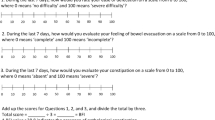Abstract
The optimal management of opioid-induced constipation (OIC) involves the use of laxatives as prophylaxis and first-line therapy, with diet, lifestyle and medication modifications where appropriate, and targeted therapy (e.g. peripherally acting μ-opioid receptor antagonists) or lubiprostone in patients who do not respond adequately to, or who are not suitable candidates for laxative and lifestyle interventions. There are no specific guidelines for the treatment of OIC in the elderly, and treatment decisions should be based on the individual patient’s circumstances and/or limitations.

Similar content being viewed by others
References
Drewes AM, Munkholm P, Simren M, et al. Definition, diagnosis and treatment strategies for opioid-induced bowel dysfunction-recommendations of the Nordic Working Group. Scand J Pain. 2016;11:111–22.
Camilleri M, Drossman DA, Becker G, et al. Emerging treatments in neurogastroenterology: a multidisciplinary working group consensus statement on opioid-induced constipation. Neurogastroenterol Motil. 2014;26(10):1386–95.
Kumar L, Barker C, Emmanuel A. Opioid-induced constipation: pathophysiology, clinical consequences, and management. Gastroenterol Res Pract. 2014;2014:141737.
Argoff CE, Brennan MJ, Camilleri M, et al. Consensus recommendations on initiating prescription therapies for opioid-induced constipation. Pain Med. 2015;16(12):2324–37.
Chokhavatia S, John ES, Bridgeman MB, et al. Constipation in elderly patients with noncancer pain: focus on opioid-induced constipation. Drugs Aging. 2016;33(8):557–74.
Caraceni A, Hanks G, Kaasa S, et al. Use of opioid analgesics in the treatment of cancer pain: evidence-based recommendations from the EAPC. Lancet Oncol. 2012;13(2):e58–68.
Chou R, Fanciullo GJ, Fine PG, et al. Clinical guidelines for the use of chronic opioid therapy in chronic noncancer pain. J Pain. 2009;10(2):113–30.
Hunold KM, Smith SA, Platts-Mills TF. Constipation prophylaxis is rare for adults prescribed outpatient opioid therapy from U.S. emergency departments. Acad Emerg Med. 2015;22(9):1118–21.
Pottegård A, Knudsen TB, van Heesch K, et al. Information on risk of constipation for Danish users of opioids, and their laxative use. Int J Clin Pharm. 2014;36(2):291–4.
Mounsey A, Raleigh M, Wilson A. Management of constipation in older adults. Am Fam Physician. 2015;92(6):500–4.
Christensen HN, Olsson U, From J, et al. Opioid-induced constipation, use of laxatives, and health-related quality of life. Scand J Pain. 2016;11:104–10.
Adis Insight. Drug profile: naldemedine. http://adisinsight.springer.com. Accessed 11 Jan 2016.
Adis Insight. Drug profile: axelopran. http://adisinsight.springer.com. Accessed 11 Jan 2016.
Relistor 13 mg/0.6 mL solution for injection: EU summary of product characteristics. London: European Medicines Agency; 2016.
Relistor® (methylnaltrexone bromide) tablets and injection: US prescribing information. Bridgewater: Salix Pharmaceuticals; 2016.
Thomas J, Karver S, Cooney GA, et al. Methylnaltrexone for opioid-induced constipation in advanced illness. N Engl J Med. 2008;358(22):2332–43.
Bull J, Wellman CV, Israel RJ, et al. Fixed-dose subcutaneous methylnaltrexone in patients with advanced illness and opioid-induced constipation: results of a randomized, placebo-controlled study and open-label extension. J Palliat Med. 2015;18(7):593–600.
Michna E, Blonsky ER, Schulman S, et al. Subcutaneous methylnaltrexone for treatment of opioid-induced constipation in patients with chronic, nonmalignant pain: a randomized controlled study. J Pain. 2011;12(5):554–62.
Moventig (naloxegol) 12.5 and 25 mg film-coated tablets: EU summary of product characteristics. London: European Medicines Agency; 2016.
Movantik® (naloxegol) tablets, for oral use: US prescribing information. Wilmington: AstraZeneca Pharmaceuticals; 2016.
Chey WD, Webster L, Sostek M, et al. Naloxegol for opioid-induced constipation in patients with noncancer pain. N Engl J Med. 2014;370(25):2387–96.
Webster L, Chey WD, Tack J, et al. Randomised clinical trial: the long-term safety and tolerability of naloxegol in patients with pain and opioid-induced constipation. Aliment Pharmacol Ther. 2014;40(7):771–9.
Tummala R, Diva U, Sostek M. Treatment with naloxegol versus placebo: safety assessment in patients aged ≥65 years with noncancer pain and opioid-induced constipation [abstract no. Sa1398]. Gastroenterol. 2015;148(Suppl 4):S-134.
Stein C, Clark JD, Oh U, et al. Peripheral mechanisms of pain and analgesia. Brain Res Rev. 2009;60:90–113.
Amitiza (lubiprostone) capsules: US prescribing information. Rockville: Sucampo Pharma; 2016.
Cryer B, Katz S, Vallejo R, et al. A randomized study of lubiprostone for opioid-induced constipation in patients with chronic noncancer pain. Pain Med. 2014;15(11):1825–34.
Jamal MM, Adams AB, Jansen JP, et al. A randomized, placebo-controlled trial of lubiprostone for opioid-induced constipation in chronic noncancer pain. Am J Gastroenterol. 2015;110(5):725–32.
Spierings EL, Rauck R, Brewer R, et al. Long-term safety and efficacy of lubiprostone in opioid-induced constipation in patients with chronic noncancer pain. Pain Pract. 2015;16(8):985–93.
Author information
Authors and Affiliations
Consortia
Ethics declarations
The article was adapted from Drugs and Aging 2016;33(8):557–74 [5] by salaried employees of Adis/Springer and was not supported by any external funding.
Rights and permissions
About this article
Cite this article
Adis Medical Writers. Laxatives, targeted therapy and lubiprostone are options when individualizing treatment for opioid-induced constipation in the elderly. Drugs Ther Perspect 33, 174–180 (2017). https://doi.org/10.1007/s40267-017-0389-7
Published:
Issue Date:
DOI: https://doi.org/10.1007/s40267-017-0389-7




